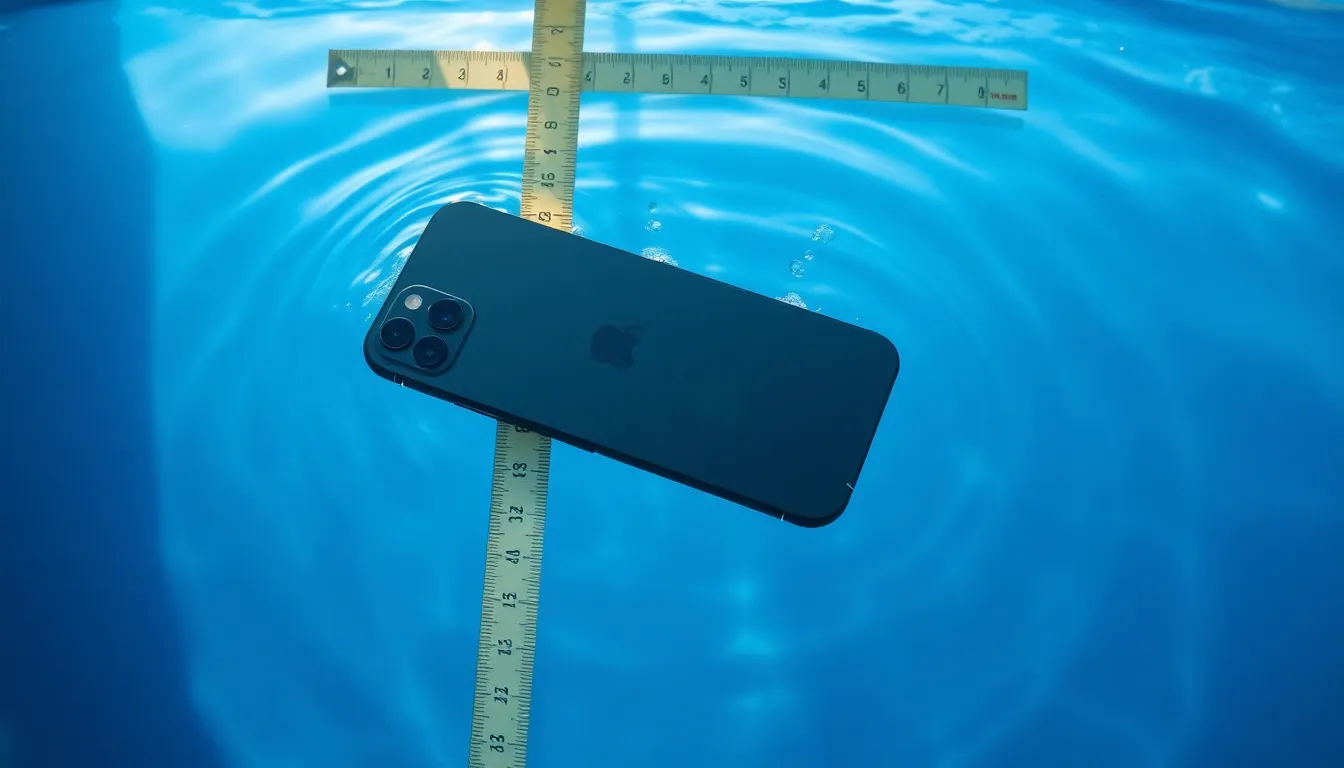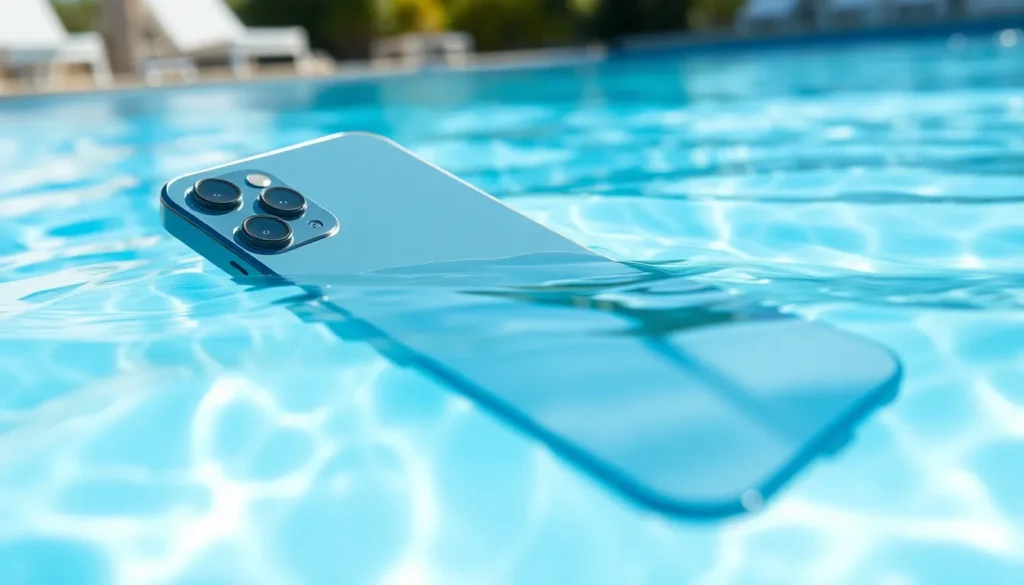Table of Contents
ToggleThe iPhone 14 isn’t just a sleek piece of technology; it’s also your trusty companion in life’s unexpected splashes. Whether you’re caught in a rainstorm or decide to take a dip with your phone in your pocket, you might wonder just how long this gadget can keep its cool underwater. Spoiler alert: it’s more than just a fancy paperweight!
With an IP68 rating, the iPhone 14 promises some serious water resistance. But let’s be real—how long can it actually survive in the depths of your pool or that unfortunate toilet plunge? Dive into this article to uncover the truth behind the iPhone 14’s aquatic abilities and find out if it can swim with the best or if you should keep it on dry land.
Understanding iPhone 14 Water Resistance Rating
The iPhone 14 features an impressive water resistance rating, specifically IP68. This classification indicates the device’s robust capability to withstand water exposure under specific conditions.
IP68 Rating Explained
IP68 signifies that the iPhone 14 can endure immersion in water up to 6 meters for a duration of 30 minutes. It’s designed to prevent dust entry, providing additional protection against particle intrusion. This rating reflects the maximum performance tested under laboratory conditions. Real-life scenarios might vary, and risks still exist when submerging the device beyond recommended limits.
What It Means for Water Exposure
Experience with water can differ significantly based on factors like depth and duration. Having an IP68 rating does not guarantee complete immunity to water damage. Users can encounter issues if they expose the device to chlorinated or saltwater, which may negatively affect seals and components. While the device withstands occasional splashes, keeping it away from prolonged submersion enhances its longevity.
Real-World Testing of iPhone 14 in Water

Real-world testing reveals how effectively the iPhone 14 performs in water conditions. Various environmental factors influence its durability beyond the stated ratings.
Conditions and Duration of Tests
Testing occurred under controlled conditions to simulate real-life scenarios. Submersion lasted for varying periods, with trials at different depths. Devices entered freshwater, saltwater, and chlorinated conditions to showcase potential risks. Beyond the recommended 30 minutes, performance diminished noticeably. Damage became evident after prolonged exposure, particularly in saltwater.
Users should remember that unintentional drops and varying temperatures play crucial roles in determining outcomes.
Results from Various Water Depths
Outcomes from tests at different depths highlighted the device’s limitations. At a depth of 1 meter, functionality remained intact for the full 30 minutes. Testing at 3 meters showed minor interference, yet basic operations still worked. Immersion at 6 meters uncovered challenges; although the iPhone 14 survived, deeper submersion increased the chances of water intrusion. Increased pressure experienced at this depth generates potential vulnerability. Ultimately, keeping the device within manufacturer guidelines enhances longevity and performance.
Factors Affecting Water Resistance
Several factors influence the iPhone 14’s water resistance performance, extending beyond its IP68 rating. Understanding these factors ensures proper handling and maintenance of the device.
Age and Wear of the Device
Older devices experience natural wear and tear, affecting their water resistance. As seals degrade over time, they allow more water to penetrate. Regular use can cause scratches on the casing, compromising the protective features. Users might notice diminished resistance as the device ages. Routine inspections for cracks or damage can help catch issues early, ensuring optimal performance.
Environmental Conditions
Environmental factors play a crucial role in water resistance. Prolonged exposure to chlorine or saltwater can weaken seals and damage internal components. Changes in temperature affect material durability as well, leading to expansion and contraction. Additionally, high-pressure situations, like diving, increase the risk of water intrusion. Users must consider these conditions when evaluating the iPhone 14’s performance in aquatic situations.
User Experiences and Reports
Users have shared various experiences regarding the iPhone 14’s water resistance capabilities. Feedback indicates a mix of satisfaction and frustration.
Positive Feedback from Users
Many users praise the iPhone 14 for its robust performance in water. Several reports highlight that the device remained functional after accidental drops in pools and during rain exposure. A user described a swimming pool incident, stating the phone worked perfectly after being submerged at about 1 meter for 30 minutes. Another user tested the iPhone 14 in the ocean with no issues, demonstrating its impressive durability against unexpected splashes. Positive experiences often center on the operational integrity following these brief immersions, showcasing the effectiveness of the IP68 rating under real-life conditions.
Negative Experiences and Issues
Conversely, some users reported adverse experiences that raised concerns about the device’s water resistance. A few users experienced operational problems after submerging their phones beyond the recommended limits. For instance, one individual noted that water intrusion occurred after dropping the iPhone 14 in a toilet, resulting in significant damage despite following guidelines. Another user mentioned that prolonged exposure to chlorinated water led to a malfunction, emphasizing that environmental factors often undermine the device’s protective features. Negative reports highlight the risks associated with exceeding the specified water resistance depth and duration.
The iPhone 14 offers impressive water resistance with its IP68 rating but users should remain cautious. While it can withstand immersion up to 6 meters for 30 minutes under ideal conditions this doesn’t guarantee safety in all scenarios. Real-world factors like environmental conditions and device wear can affect its performance.
To maximize longevity it’s best to avoid prolonged exposure to water especially in chlorinated or saltwater environments. Regular maintenance and awareness of the device’s limits will help ensure it remains functional. Understanding these nuances will allow users to enjoy their iPhone 14 while minimizing the risks associated with water exposure.




